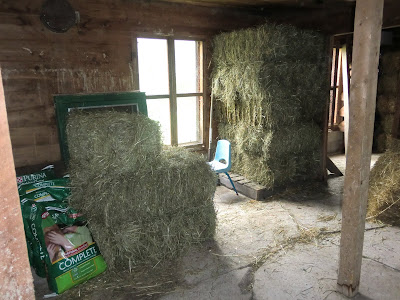This post comes hot on the heels of the previous one, so be sure to go back to see an explanation of why this is here.
Here's a fairly easy method to estimate hay needs for goats. I used it to estimate how much hay to get to last our animals 6 months (October through March). I'm starting out with 2 Dwarf Nigerian Dairy goats that will be bred when I get them.
You'll start with the estimate that your goats will eat roughly 5% of their body weight in hay per day. You will need more than this, however, since there is waste. How much waste depends on the feeding system you have in place. Using a hay feeder that keeps the goats from laying on the hay and keeps the hay off the ground should result in 10 to 20% waste. You could estimate 15%.
I'm estimating my goats to weigh a combined total of 160 pounds when I get them. My equation will look like this:
160 (pounds) x .05 (percent turned to a decimal) = 8 (pounds of hay per day)
8 (pounds of hay per day) x 180 (days in 6 months) = 1440 (pounds of hay for 6 months)
1440 (6 months hay) x .15 (percent waste turned to decimal) = 216 (extra pounds needed for waste)
1440 + 216 = 1622 pounds of hay needed for 6 months
I've been extravagant with the amount of hay I purchased because the does will be in kid and we will have two breeding pairs of rabbits who also eat hay. I also didn't realize that the alfalfa bales would weigh so much more than the timothy.
So, now I have 25 bales of timothy hay at 50 pounds each = 1250 pounds
15 bales of Alfalfa hay at 100 pounds each = 1500 pounds
Total of 3050 pounds of hay. According to "the formula" this should be way more than we need.
I'll keep you posted.
I also wanted to say a word about the hay I chose and why. There are a lot of different ideas about what to feed goats even among experienced goeat farmers. One practice is to feed only the leafiest alfalfa that you can find. Proponents say that this is the best food for goats, they grow quickly and are well maintained on this hay.
The other practice is to feed only grass hay. Some say that the animals need the longer fibers in this hay to develop and work the rumen properly. They feel that the slower but steady growth is better for the goats in the long run, proving to make their frame stronger, be more gentle on their internal organ development and create a stronger, more disease resistant animal.
I've listened to people talk about these ideas, and read a ton about this. I have no experience with it at all so far myself. Because I don't know yet how I feel about this, I decided to go with a middle of the road approach. Feed some of each. My plan is to give them a limited amount of the alfalfa (say, about four pounds between them) and them fill the hay manger with the timothy free choice. We'll use the alfalfa for the rabbits too. They will probably eat a few pounds a day among them all.
The feed I chose is based on some information I read at this very informative website http://fiascofarm.com/goats/feeding.htm . I did, however, run into something that said to NEVER feed your goats equine feed mixes just a second ago. Ok, so opinions very a LOT. The site above, which I've gone to for info a lot in the past said that you should use equine feeds since they contain selenium and copper, which the goats need. Pregnant goats especially need selenium, as a shortage can cause spontanious abortion.
Ok, that's all for now!
Oops! I forgot to report on cost here. This information will be accurate only for my area of the country though. I'm far from the city and also far from the farming communities here in MN. I chose to go through a trusted distributor, so it's coming second party and I'm sure more expensive than if I could get it straight from the person who cut the hay.
Timothy 50 lbd. bales $4.95/ea
Alfalfa 100 lbd. bales $11.95/ea
bedding straw $5.95/ea
Purina Horse Chow #200 50 lbd. bags $12.95/ea
egg mash 100 lbd. bags $17
scratch 100 lbd. bags $14.50
















































